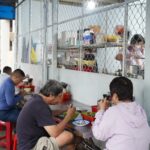A corner of Buu Long Pagoda. Photo: Ha Nguyen
Architectural Masterpiece
Perched on a hill surrounded by lush forests, Buu Long Pagoda, also known as Buu Long Zen Institute (Thu Duc City, Ho Chi Minh City), stands out with its unique architectural beauty.
According to information at the pagoda, in 1942, after taking refuge and receiving the Dharma from Zen Master Ho Tong, layman Vo Ha Thuat, who used to hold the position of the Provincial Council of Bien Hoa province, bought a plot of forest land to build a monastery.

The pagoda only has a statue of Buddha Shakyamuni and does not burn incense or lights. Photo: Ha Nguyen
In 1958, when the Vietnam Primitive Sangha was established, he offered the monastery to Zen Master Ho Tong to establish the Buu Long Zen Institute. Subsequently, the place underwent several renovations and the construction of additional items.
Throughout the construction and development process, the pagoda uniquely combines the architectural styles of four countries: India, Myanmar, Thailand, and Vietnam. It is also built according to the ancient Buddhist culture and the architectural style of the Nguyen Dynasty.



The Gotama Cetiya stupa with its breathtaking beauty is likened to the architectural masterpiece of Buu Long Pagoda. Photo: Ha Nguyen
Therefore, the pagoda boasts impressive and unique architecture in Ho Chi Minh City. Notably, in 2007, the pagoda built the great Gotama Cetiya stupa to venerate the Buddha’s relics and the Great Arahant Saints, following the Funan culture.
Spanning an area of 2,000 square meters and standing about 70 meters above sea level, the Gotama Cetiya stupa can accommodate around 2,000 people. It is considered the architectural masterpiece of Buu Long Pagoda and the largest stupa in Vietnam.

The central tower is the tallest and largest, with seven stories. Photo: Ha Nguyen
The entire Gotama Cetiya stupa is covered in pristine white, with five different large and small towers. The central tower is the tallest and largest, with seven stories. The tower’s peak is coated in gleaming gold, with a wind chime attached.
No Incense Smoke
Apart from the stupa, other items such as the Main Hall, Sangha residence, dining hall, guest hall, meditation hall for monks, nuns’ residence, nuns’ quarters, ancestral hall, hermitage for lay nuns and ascetics, etc., all feature typical Thai pagoda architectural styles.



Decorative patterns at the path leading to the stupa and outside the stupa. Photo: Ha Nguyen
Hence, Buu Long Pagoda is also known as the Thai Pagoda of Ho Chi Minh City. Following the Primitive Buddhism of the Southern School, Buu Long Pagoda only houses a statue of Buddha Shakyamuni.
The pagoda also does not burn incense or lights like other pagodas of different sects. Thus, visitors need not bring incense or lights and only need to have a sincere heart to worship the Buddha and enjoy the scenery.

In front of the stupa is a crescent-shaped lake with emerald-green water. Photo: Ha Nguyen
The pagoda’s premises span 11 hectares and are covered with abundant greenery, ancient trees, and lush landscapes. This unique feature adds to the serene and tranquil atmosphere of the pagoda.
Boasting its unique architectural beauty, in 2019, Buu Long Pagoda was recognized by the renowned National Geographic travel magazine as one of the ten most beautiful pagodas in the world.


The other structures in the pagoda also feature typical Thai pagoda architectural styles. Photo: Ha Nguyen
In recent years, the pagoda has become a pilgrimage and Buddhist worship site for Buddhists and tourists from both within and outside the country.
Currently, the pagoda is open to visitors from the morning until 11 am. In the afternoon, around 2 pm, the pagoda reopens the stupa for visitors to enter, worship the Buddha’s relics, and pay homage to the Arahant Saints’ relics.


The pagoda’s premises span 11 hectares and are covered with abundant greenery. Photo: Ha Nguyen
From the highest floor of the stupa, Buddhists and visitors can enjoy a panoramic view of the pagoda’s premises and the surrounding areas.
Nestled away from the city, amidst serene green hills, Buu Long Pagoda exudes a sense of tranquility and simplicity. Thus, it is often bustling with visitors, especially on weekends, who come to worship and take photos.

Buu Long Pagoda was recognized by National Geographic travel magazine as one of the ten most beautiful pagodas in the world in 2019. Photo: Ha Nguyen
The Heart of Saigon’s 3 a.m. Market: A 50-Year Legacy Built on a Single Trade
Chợ Lưu Xuân Tín is a renowned wholesale and retail supplier of ornamental fish in Ho Chi Minh City and its surrounding provinces, including Binh Phuoc, Tay Ninh, Dong Nai, Binh Duong, and Long An. We pride ourselves on being the go-to source for both traders and enthusiasts alike, offering a wide range of exotic and beautiful fish to suit any aquarium or pond. With a strong focus on quality and customer satisfaction, we strive to be the leading provider of vibrant and healthy fish, ensuring that our customers can always find what they need to create their dream aquatic habitats.
The Ultimate Ho Chi Minh City Experience: A Day Trip to Remember with Vietnam Adventure Tours
Vietnam Adventure has recognized the growing demand for day tours from Ho Chi Minh City, especially among young locals and expats. With our busy work and study schedules, we often don’t have the luxury of taking extended vacations. Our day tours offer a perfect opportunity to reset and rejuvenate before getting back to the grind.






































